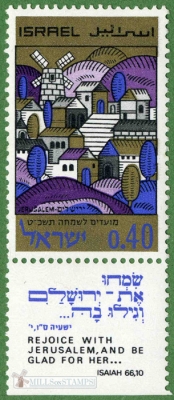-
Jewish new year. Jerusalem
Israel 1968.08.21
In issue: Stamp(s): 5
Issued in: sheets of 15 (5*3) stamps
-
Number by catalogue: Michel: 428 Yvert: 366 Scott: 373
Perforation type: 14x13
Subject:
40 agorot. Yemin Moshe District** and Mount of Olives*
Additional:
*The Mount of Olives, also Mount Olivet - is a mountain ridge in east Jerusalem with three peaks running from north to south. The highest, at-Tur, rises to 818 meters (2,683ft). It is named for the olive groves that once covered its slopes. The Mount of Olives is associated with Jewish and Christian traditions.
The Mount of Olives is first mentioned in connection with David's flight from Absalom (II Samuel 15:30): "And David went up by the ascent of the Mount of Olives, and wept as he went up." The ascent was probably east of the City of David, near the village of Silwan. The sacred character of the mount is alluded to in the Ezekiel (11:23): "And the glory of the Lord went up from the midst of the city, and stood upon the mountain which is on the east side of the city." Solomon built altars to the gods of his wives on the southern peak (I Kings 11:7-8). During the reign of King Josiah, the mount was called the Mount of Corruption (II Kings 23:13).
The New Testament, tells how Jesus and his friends sang together - "When they had sung the hymn, they went out to the Mount of Olives" [Matthew] 26:30.Roman soldiers from the 10th Legion camped on the Mount during the Siege of Jerusalem in the year 70 CE, which led to the destruction of the city.
King Hussein permitted the construction of the Intercontinental Hotel at the summit of the Mount of Olives together with a road that cut through the cemetery which destroyed hundreds of Jewish graves, some from the First Temple Period. Some fifty thousand Jewish graves out of a total seventy thousand were allegedly destroyed or defaced during the nineteen years of Jordanian rule, although this is disputed by many authorities. After the Six-Day War, restoration work began, and the cemetery was re-opened for burials.
The Arab neighborhood of at-Tur is located on the mountain's summit. Landmarks on the Mount of Olives include Yad Avshalom, the Tomb of Zechariah, the Church of all Nations, the Church of Maria Magdalene, Dominus Flevit Church, Gethsemane, Mary's Tomb, the Mount of Olives Hotel and the Seven Arches Hotel.
**Yemin Moshe is an old neighborhood in Jerusalem, Israel, overlooking the Old City.
Yemin Moshe was established in 1891 by Moses Montefiore outside Jerusalem's Old City as a solution to the overcrowding and unsanitary conditions inside the walls, and eventually named for him. Few people were anxious to live there at the time, because the area was open to Arab marauders. The original houses were built with a wall around them and a gate that was locked at night.
Mishkenot Sha'ananim, as the first houses were known, consisted of two rows of buildings. The first was completed by 1860 and contained 28 apartments of one-and-a-half rooms. The compound also had a water cistern with an iron pump imported from England, a mikveh and a communal oven.
The second row of houses was built in 1866 when a cholera epidemic was at its height in the Old City. Some of the people who took up residence in the new neighborhood refused to stay there at night, but that year, the demand for apartments rose as illness spread.Topics: Mills within the landscapes Stylized mills Windmills



